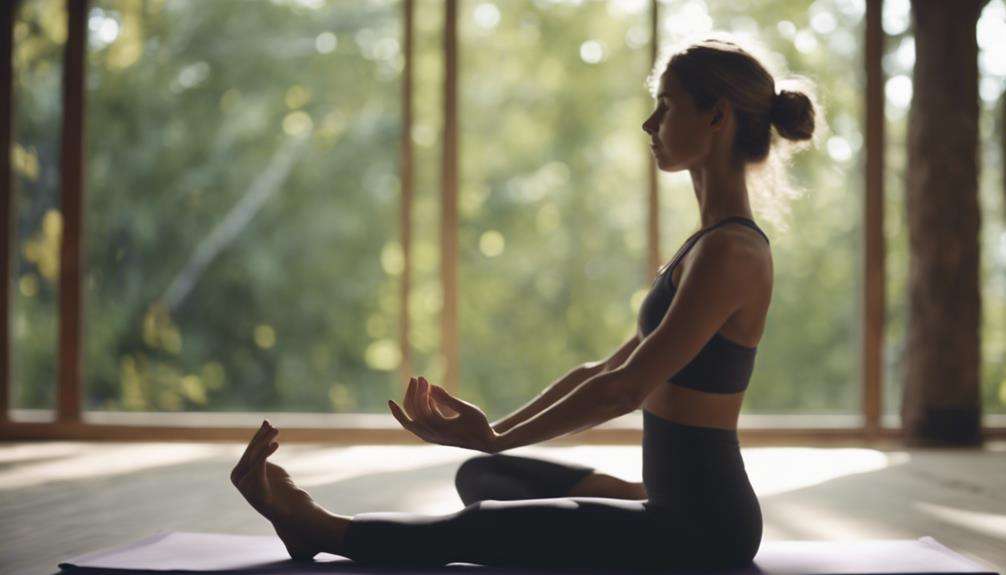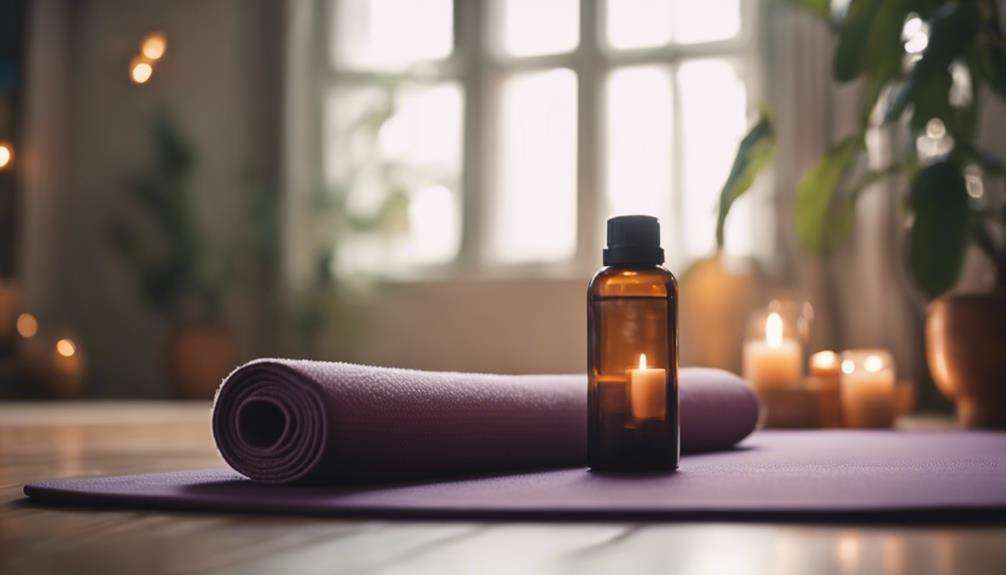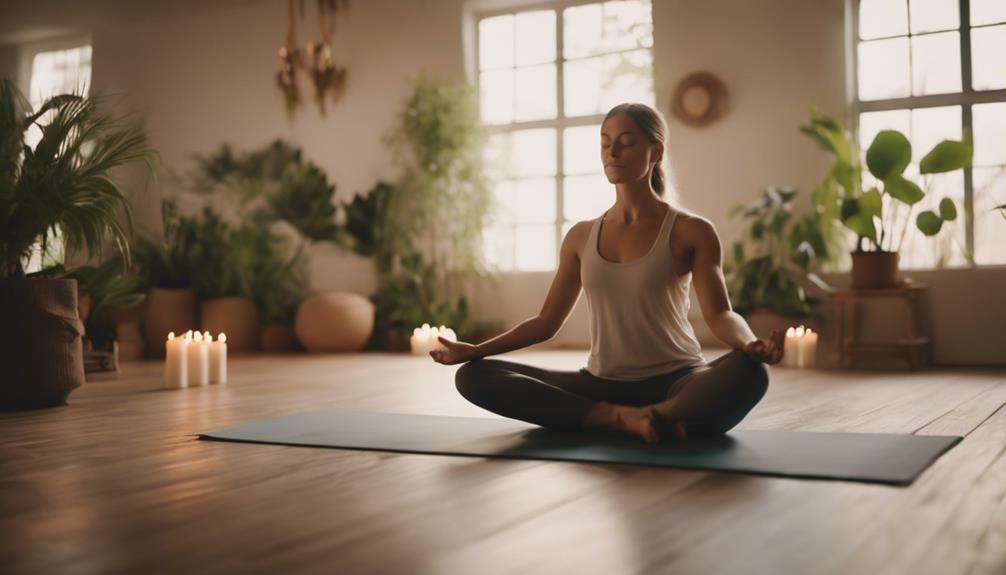In today's fast-paced world, you often navigate through moments that challenge your inner calm. Discover how the ancient practice of yoga can serve as a powerful ally in your quest for stress relief.
By exploring the intricate connection between body and mind, you'll uncover a pathway that leads to more than just physical relaxation.
Curious to unravel how yoga's holistic approach can transform your response to stress and cultivate a sense of inner peace?
Key Takeaways
- Engage in regular yoga practice to lower cortisol levels and reduce stress.
- Foster a mind-body connection for cortisol modulation and overall well-being.
- Utilize relaxation methods in yoga to address stress symptoms and root causes.
- Enhance self-awareness and mental clarity through yoga to cope with stress sources.
How Yoga Reduces Stress
Discover how practicing yoga can actively alleviate your stress levels by engaging the body's relaxation response and reducing cortisol levels.
Yoga is a powerful tool for stress relief as it focuses on the mind and body connection, allowing you to release tension and find inner peace.
By incorporating yoga poses, breathwork, and meditation into your routine, you can effectively manage stress and improve your overall well-being.
The practice of yoga promotes mindfulness, which helps reduce anxiety and cultivate a sense of calm within you.
Through yoga, you can enhance your self-awareness and mental clarity, enabling you to better understand and cope with the sources of your stress.
Embrace the holistic approach of yoga to not only address the symptoms of stress but also to uncover and work through the root causes, leading to long-lasting stress relief and a more balanced life.
Impact of Yoga on Cortisol Levels
When you practice yoga, you're actively helping to regulate your cortisol levels, the hormone linked to stress.
By engaging in yoga regularly, you're promoting a healthier balance of cortisol, which can lead to a more relaxed and less anxious state.
Studies support the idea that yoga can effectively lower cortisol levels, contributing to your overall well-being and sense of calm.
Cortisol Regulation in Yoga
Yoga practice effectively regulates cortisol levels, the primary stress hormone in the body, promoting stress relief and overall well-being. When you engage in yoga, you're not just stretching the entire body; you're also supporting your mental health. By incorporating yoga into your routine, you can actively lower cortisol levels, which in turn helps relieve stress and uplift your mood.
Studies have shown that practicing yoga can lead to a decrease in cortisol production, contributing to a healthier stress response. The relaxation techniques in yoga, such as focusing on your breath and learning to quiet the mind, play a crucial role in balancing cortisol secretion.
Yoga for Stress
Engage in regular yoga practice to effectively lower cortisol levels, promoting relaxation and enhancing your stress management capabilities. By incorporating specific yoga techniques into your routine, you can actively combat stress and its effects on your body.
Here's how yoga helps with stress management:
- Cortisol Regulation: Yoga has been scientifically proven to lower cortisol levels, reducing the body's stress response.
- Mind-Body Connection: The practice of yoga fosters a strong mind-body connection, which aids in modulating cortisol levels and alleviating stress.
- Relaxation Methods: Through yoga, you can learn various relaxation methods that not only lower cortisol but also promote overall well-being and calmness.
Balancing the Nervous System With Yoga

When it comes to balancing your nervous system with yoga, it's essential to focus on practices that engage both the sympathetic and parasympathetic branches.
By incorporating deep breathing and mindfulness techniques, you can trigger the relaxation response and decrease stress hormone levels effectively.
Poses like Legs-Up-the-Wall and Child's Pose offer a gentle way to calm your nerves and promote a sense of relaxation in your body.
Nervous System Regulation
By incorporating specific breathing techniques and gentle movements, you can effectively balance your nervous system through yoga practice. Yoga helps regulate the nervous system by activating the body's relaxation response, stimulating the parasympathetic nervous system, and promoting a healthy balance between the sympathetic and parasympathetic nervous systems.
This balance reduces stress and anxiety, fostering a sense of calm. The practices in yoga that focus on relaxation and mindfulness support nervous system regulation by enhancing the mind-body connection. Engaging in consistent yoga practice can aid in maintaining this equilibrium, ensuring your nervous system functions optimally to cope with daily stressors and promote overall well-being.
Yoga for Relaxation
To achieve optimal relaxation and balance your nervous system through yoga practice, consider incorporating specific poses and breathing techniques that promote a sense of calm and reduce stress. Gentle stretches like Child's Pose and Legs-Up-the-Wall are excellent for activating the parasympathetic nervous system, inducing a state of relaxation.
Guided meditation can help calm the body's fight-or-flight response by incorporating deep belly breathing techniques, balancing the autonomic nervous system. Restorative poses such as Cat-Cow Pose and Standing Forward Bend release tension in the spine, soothing the central nervous system.
Enhancing Mindfulness Through Yoga
Curious about how yoga can deepen your mindfulness practice and enhance your overall well-being? By incorporating mindful movement, present awareness, and emotional balance into your yoga practice, you can cultivate a profound sense of connection between your body and mind.
- Mindful movement: Yoga encourages you to move with intention, focusing on the present moment and the sensations within your body. This mindful approach helps you stay grounded and centered.
- Present awareness: Through yoga, you learn to be fully present on your mat, allowing yourself to let go of distractions and worries. This present awareness can then be carried off the mat into your daily life, promoting a more mindful way of living.
- Emotional balance: Practicing mindfulness in yoga involves acknowledging your thoughts and emotions without judgment. This acceptance can lead to emotional balance, reducing stress and anxiety while enhancing mental clarity.
Incorporating these elements into your yoga routine can't only help you relieve stress but also foster a greater sense of well-being and harmony in your life.
Yoga Poses for Relaxation

For a moment of tranquility and rejuvenation, explore these yoga poses tailored to promote relaxation and release tension in both body and mind. Gentle stretches are key to easing the body and calming the mind.
Child's Pose, for instance, helps release tension in the back and shoulders while fostering a deep mind-body connection.
The Cat-Cow Pose improves spinal flexibility and encourages gentle movements that can bring a sense of peace.
Standing Forward Bend is another wonderful pose that not only stretches the hamstrings but also relieves stress in the back and neck, aiding in overall relaxation.
Legs-Up-the-Wall Pose is a powerful relaxation technique that increases blood flow to the heart and calms the nervous system.
Breathing Techniques for Stress Relief
When seeking relief from stress, incorporating specific breathing techniques can profoundly impact your sense of calm and relaxation. By focusing on your breath, you can harness its power to ease stress and promote a tranquil state of mind. Here are some effective breathing techniques to help you combat stress:
- Deep Belly Breathing for Relaxation: Deep belly breathing increases the flow of oxygen to your muscles, inducing a state of relaxation that can alleviate stress and tension in your body. By engaging your diaphragm and taking slow, deep breaths, you signal to your body that it's time to unwind.
- Rhythmic Breathing for Mental Clarity: Embracing rhythmic breathing patterns during yoga practice can calm your nervous system and enhance mental clarity. The steady rhythm of your breath synchronizes with your movements, fostering a sense of peace and focus that aids in stress relief.
- Breathwork Techniques like Ujjayi Breathing: Practices like Ujjayi breathing help reduce anxiety and tension by encouraging slow, deliberate breaths that engage your entire respiratory system. This mindful breathing technique can bring about a sense of calm and relaxation, making it a valuable tool in managing stress.
Creating a Calm Space for Yoga

To cultivate a tranquil environment conducive to your yoga practice, consider designating a quiet, clutter-free space with natural light. Creating sanctuary is essential for your well-being during yoga sessions. Opt for calming colors like blues and greens to establish a serene ambiance in your Zen zone.
Incorporate mindful decor elements such as candles, cushions, or plants to enhance relaxation and create a peaceful atmosphere. Keep your yoga props neatly organized, ensuring easy access to mats, blocks, and straps. Personalize your space with inspirational quotes, soothing artwork, or a dedicated altar for mindfulness.
Incorporating Meditation Into Yoga Practice
Consider incorporating meditation into your yoga practice as a powerful tool for enhancing mindfulness and inner peace. By combining meditation with yoga, you can deepen your practice and experience a profound mind-body connection. Here are some benefits of incorporating meditation into your yoga routine:
- Meditation Benefits:
Meditation involves focusing on breath, thoughts, or sensations to cultivate mindfulness. It helps reduce stress, calm the mind, promote relaxation, and enhance emotional well-being.
- Mind-Body Connection:
Integrating meditation into yoga enhances the connection between your mind and body. This synergy can lead to increased self-awareness, emotional stability, and resilience to everyday stressors.
- Inner Peace Cultivation:
Regular practice of meditation within yoga fosters a sense of inner peace. Mindfulness meditation has been associated with decreased anxiety, improved sleep quality, and enhanced cognitive function. Embrace the transformative power of meditation in your yoga practice to nurture your well-being holistically.
Frequently Asked Questions
What Type of Yoga Is Best for Stress Relief?
For stress relief, opt for restorative, gentle, or yin yoga. These types focus on deep stretching, relaxation techniques, and mindfulness. Embrace gentle stretching, deep breathing, and slow movements. Enhance mind-body connection through meditation practices for ultimate relaxation.
How Effective Is Yoga for Stress Relief?
Yoga techniques, backed by scientific evidence, are highly effective for stress relief. They enhance the mind-body connection, trigger the relaxation response, regulate stress hormones, and improve emotional well-being. Incorporate yoga into your routine for lasting calmness.
Which Yoga Is Best for Anxiety and Depression?
For anxiety and depression, focus on Hatha, Restorative, or Yin yoga. These styles emphasize deep breathing, slow movements, and relaxation. They activate your body's calming responses, release tension, and promote emotional balance effectively.
Which Aspect of Yoga Is Particularly Beneficial for Stress Reduction and Mental Well-Being?
To enhance mental well-being and reduce stress, focus on incorporating breathwork techniques, mindfulness practices, and stress-reducing postures in your yoga routine. These aspects promote relaxation, presence, and physical ease, nurturing your overall emotional balance.
Conclusion
In conclusion, incorporating yoga into your routine can significantly reduce stress levels and promote overall well-being. Studies have shown that practicing yoga for as little as 15-30 minutes a day can lower cortisol levels by 27%.
By engaging in yoga poses, breathing techniques, and mindfulness practices, you can create a calm space for relaxation and stress relief. Remember, taking care of your mental health is just as important as your physical health.
Keep up the yoga practice for a happier, healthier you.






